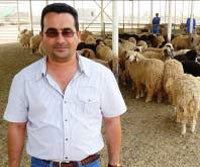
The herders of south-central Iraq have traditionally let their sheep graze on the land. But grass and reeds are scarce and the animals are often small when taken to market.
Ahmad Alsaabari, an engineer by training, had read about the success of Western foodlots and recognized the opportunity when the U.S. Agency for International Development (USAID) proposed founding of a demonstration facility in Babil Province, where lambs are considered among the best in Iraq.
“USAID worked with us through the formation of a business plan, construction, and the technical aspects of feeding, marketing, and accounting,” said Alsaabari, who matched USAID’s $300,000 investment to build the feedlot. “We have now trained more than 1,000 people to raise and market sheep.”
Alsaabari’s father, Habib, who previously raised sheep using traditional methods, embraced the new techniques which include tagging and closely monitoring each lamb’s health after its purchase from local breeders, then tracking each lamb’s growth until it is fattened for market in just four months’ time.
The Alsaabaris’ lambs weigh more than most at market, 60 kilograms versus the average 40 kilos. This initially was problematic, because Iraqi sheep are traditionally sold by the head rather than weight. But the Alsaabaris’ lambs were recognized for their quality by discriminating buyers from Baghdad who pay a premium for excellence and are willing to buy by weight.
“In the past, farmers gave little thought about how to raise their stock,” says Ahmad Alsaabari. “Now they ask us what percent of protein they should feed their animals. We provide technical information and teach them to formulate business plans.”
The Alsaabaris, who are bolstering the local economy by training and employing 10 laborers, are developing new business models. They will begin butchering operations to improve their feedlot’s profitability and invest another $300,000 of their funds to launch a cattle feedlot that will serve as a community model.







Comment
Make a general inquiry or suggest an improvement.